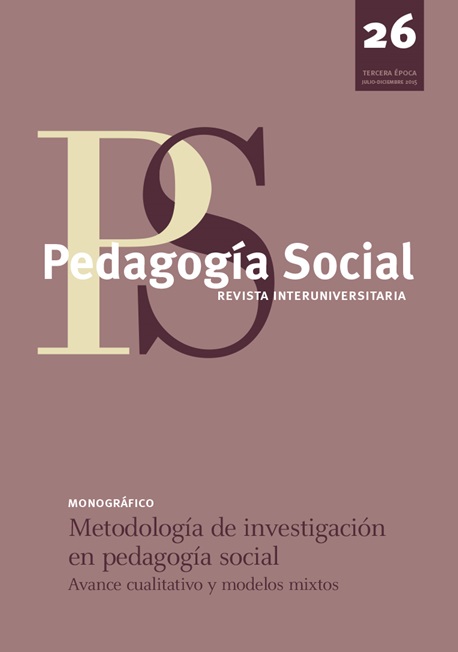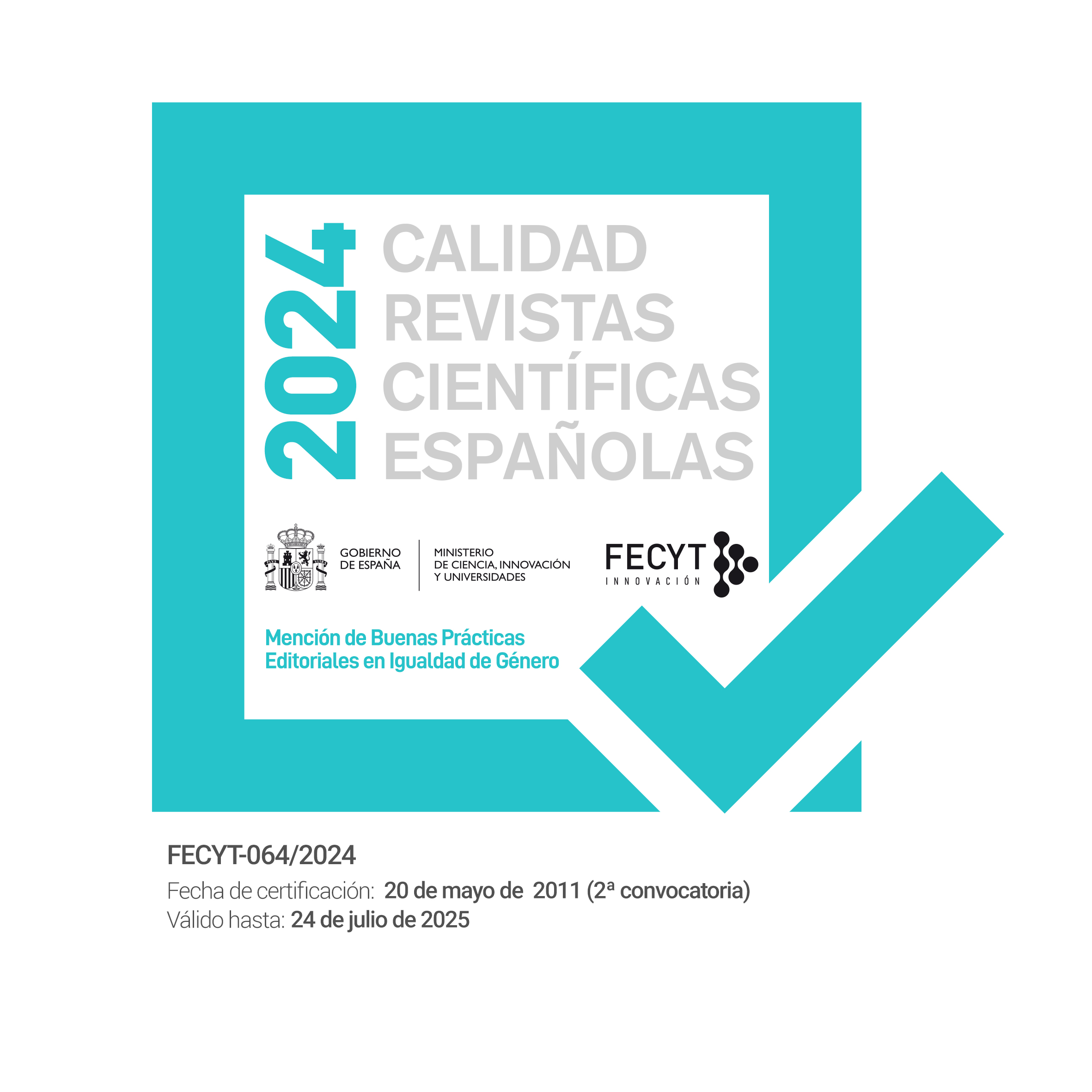Indicators of gender violence in romantic relationships. Case study in chilean adolescents
DOI:
https://doi.org/10.7179/PSRI_2015.26.04Keywords:
Adolescents, Attitudes Adolescent, Couple’s Relationships, Gender violence, SexismAbstract
The presence of gender violence is increasing alarmingly in our society and has become one of our most serious social problems. The data indicate that the origin of much of this type of behaviour has its roots in early adolescent relationships, in which the presence and repetition of chauvinist patterns and models has been verified. In this paper we assume that this kind of conduct is related to socially accepted behaviours that form part of the normative patterns typical of socialization processes. To analyse this thesis, an interdisciplinary group of researchers from Spanish and Chilean universities carried out a qualitative study on behaviours associated with gender violence in groups of adolescents and young people from different economic, geographic, social and ethnic contexts in order to gather evidence about the ways adolescents establish romantic or intimate relationships and to determine whether there are any indications of male chauvinist violence against adolescent women. The research design proposed takes as a reference the principles of Grounded Theory and employs the constant comparative method, that is, the information is collected, coded and analysed simultaneously, with theoretical sampling that involves selecting new cases as a function of their potential to help refine or expand the concepts and theories already developed. Thus, the coding of the discourse was carried out using open coding, axial coding and selective coding, and finally grouping the relevant categories or ideas into meta-categories to build the theoretical schema. Participating in the study were 156 adolescents (77 girls and 79 boys) residing in the urban area of the Arica region in Chile, having been selected according to the variables “academic year” and “age”. Seventeen discussion groups were formed until data saturation was attained. The findings show that in these first adolescent dating relationships there is an important number of negative references and references to violent chauvinist behaviour, in particular psychological violence, in which there is a clear, rigid, culturally assimilated structuring of gender roles in which the values of strength, power and dominance appear as belonging to a masculine identity. These “values” are at the basis of structures of inequality, and one means of attaining them and defending them is through aggression. In contrast, female identity is constructed with the attributes of weakness, control and need for protection. These values are transmitted as norms of desirable behaviour and are inserted into the very identity of adolescent women. Finally we discuss the need for greater institutional resolve in the improvement of equality programs and the development of educational proposals to enable intervention programs to be designed and prioritized. This should be done with a view to promoting more egalitarian dating relationships in adolescence and young adulthood, as a means to educate for prevention of abusive behaviour in adolescent dating and the construction of non-aggressive love relationships.
Downloads
References
Bas Peña, E., Pérez de Guzmán Puya, V., & Vargas Vergara, M. (2014). Educación y Género: la formación de los educadores y educadoras sociales. Pedagogía Social. Revista Interuniversitaria, 23, pp. 95-120.
Bosch, E., & Ferrer, V. (2002). La voz de las invisibles. Las víctimas de un mal amor que mata. Madrid: Cátedra.
Bosch, E., Ferrer, V., & Alzamora, A. (2006). El laberinto patriarcal. Reflexiones teórico-prácticas sobre la violencia contra las mujeres. Barcelona: Anthropos.
Cantera, I., Estébanez, I., & Vázquez, N. (2009) Violencia contra las mujeres jóvenes: la violencia psicológica en las relaciones de noviazgo. Módulo psicosocial de Deusto. San Ignacio. Bilbao
Delgado, C., & Mergenthaler, E. (2011). Evaluación psicométrica de la percepción de la violencia de género en la adolescencia. International Journal of Developmental and Educational Psycholoy. INFAD. Revista de Psicología nº 1.vol.2, pp. 197.206
Delgado, C., & Martín, M. F. (2004). Falsas creencias sobre la violencia de género. Grupo de investigación: Psicología y Género y ADAVAS-Salamanca. Manuscrito no publicado. Salamanca: Universidad Pontificia Salamanca.
Delgado, C., Martín, M. F., Iraegui, A., Marquina, L., Palacios, B., Plaza, J. F., Sendín, P.P., Pérez, Mª D., Revuelta, F.I., & Sánchez, Mª C. (2007). Perfil del maltratador y la victima de la violencia de género. In C. Guillén & R. Guil (Eds.), Psicología Social: Un encuentro de perspectivas, pp. 972-980. Cádiz: Asociación de Profesionales de Psicología Social.
Díaz-Aguado. (2000). Superación del sexismo y rechazo a la violencia entre las/os adolescentes. In I. Mujer (Ed.), Las mujeres en el año 2000. Hechos y aspiraciones, pp. 55-68. Madrid: Instituto de la Mujer.
Díaz-Aguado. (2003). Adolescencia, sexismo y violencia de género. Papeles del Psicólogo, 84, pp. 35-44.
Díaz-Aguado. (2006). Sexismo, violencia de género y acoso escolar. Propuestas para una prevención integral de la violencia. Revista de Estudios de Juventud, 73(junio), pp. 38-57.
European Union Agency for Fundamental Rights (2014).
European Violence against women: an EU-wide survey. Retrieved from
http://fra.europa.eu/sites/default/files/fra-2014-vaw-survey-main-results_en.pdf
Guba, E. y Lincoln, Y. (1989). Fourth generation evaluation. Newbury Park: Sage.
Heyzer, N. (2000). Trabajando por un mundo libre de vilencia contra la mujer. En Carpeta de Documentos del Foro Mundial de Mujeres contra la Violencia, pp. 13-24. Valencia: Centro Reina Sofía para el Estudio de la Violencia.
INE (2002). Instituto Nacional de Estadística chileno. Recuperado de http://www.ine.cl/canales/chile_estadistico/estadisticas_sociales_culturales/etnias/pdf/info_etniascenso2002.pdf
Ley Orgánica de Medidas de Protección Integral contra la Violencia de Género, 1/2004 de 28 de diciembre.
Lincoln, Y.S., & Guba, E.G. (1985). Naturalistic inquiry. Beverly Hills: Sage.
Moreno, Sastre, G., & Hernández, J. (2003). Sumisión aprendida: un estudio sobre la violencia de género. Anuario de psicología, vol. 34, no2, pp. 235-251
Organización de Naciones Unidas (ONU) (1994). Declaración sobre la eliminación de la violencia contra las mujeres (Res A/R/48/104). New York: Naciones Unidas.
Observatorio contra la violencia doméstica y de género (2014). La violencia sobre la mujer en la estadística judicial: Datos anuales de 2013. Recuperado de http://www.poderjudicial.es/cgpj/es/Temas/Violencia_domestica_y_de_genero/Actividad_del_Observatorio/Datos_estadisticos/La_violencia_sobre_la_mujer_en_la_estadistica_judicial__Datos_anuales_de_2013
Palacios, B., Sánchez, Mª C., & Gutiérrez, A. (2013) Evaluar la calidad en la investigación cualitativa. Guías o checklists. Actas del Congreso Nacional de Metodología de la Investigación en Comunicación. Segovia: 2 y 3 de mayo
Sánchez Gómez, Mª C., Delgado, Mª C., & Santos, Mª C. (2012) Manual de procedimiento en la investigación cualitativa. Valladolid: Editorial Edintras
Santos, Mª C. (2009). Subtexto de género en los mensajes entre jóvenes. Aplicaciones para una educación en igualdad. (Tesis doctoral). Universidad Pontificia de Salamanca.
Sastre, G., Arantes, V., & González, A. (2007). Violencia contra las mujeres: significados cognitivos y afectivos en las representaciones mentales de adolescentes. Infancia y Aprendizaje, 30(2), pp. 197-213.
Secretaría de Estado de Servicios Sociales e Igualdad (2014). Víctimas mortales por Violencia de Género. Datos provisionales. Recuperado de http://www.msssi.gob.es/ssi/violenciaGenero/portalEstadistico/docs/VMortales_2014_01_04.pdf
Servicio Nacional de la Mujer de Chile (SERNAN) (2009). Análisis de la Violencia en las Relaciones de Pareja entre Jóvenes. Disponible en www.sernam.cl
Servicio Nacional de la Mujer de Chile (SERNAN) (2011). Violencia intrafamiliar en cifras. Encuesta de prevalencia de la violencia intrafamiliar. Disponible en www.sernam.cl
Servicio Nacional de la Mujer de Chile (SERNAN) (2014). Tasas de feminicidios. Recuperado de http://portal.sernam.cl/?m=programa&i=67
Soriano Díaz, A. (2011). La violencia en las relaciones de pareja en estudiantes universitarios. Propuestas educativas. Pedagogía Social. Revista Interuniversitaria, 18. pp.87-97
Strauss, A., & Corbin J. (1994). Grounded Theory Methodology. An Overview. En N. K. Denzin y Y. S. Lincoln (eds.). Handbook of Qualitative Research. Thousand Oaks: Sage, pp. 273-285.
Unger, R. k., & Crawford, M (1996) Women and gender: A femenist psychology. Nueva York: McGraw- Hill.
Observatorio de Equidad de Género en Salud (OEGS) (2013). Informe Monográfico 2007-2012. Violencia de Género en Chile. Recuperado de http://www.paho.org/chi/index.php?option=com_docman&task=doc_view&gid=123&Itemid
ONU (2013).Centro de Noticias ONU
Downloads
Additional Files
Published
How to Cite
Issue
Section
License
Copyright (c) 2015 Pedagogia Social. Revista Interuniversitaria

This work is licensed under a Creative Commons Attribution-NonCommercial 3.0 Unported License.
Copyright and right to archive
The published version of the articles can be self-archived by their authors in open access institutional and thematic repositories. However, Pedagogía Social. Revista Interuniversitaria must authorize partial or global reutilisation on new papers or publications.
Published papers must be cited including the title of the journal Pedagogía Social. Revista Interuniversitaria, issue, pages and year of publication
Ethical responsibilities
Pedagogía Social. Revista Interuniversitaria does not accept any material that has been previously published in other documents or publications. Authors are responsible for obtaining the required permissions for partial or global reproduction any material from other publications, and to correctly quote its origin.
Pedagogía Social. Revista Interuniversitaria is obliged to detect and report fraudulent practices.
Only those who have intellectually contribute to the development of the paper must appear as authors.
The journal expects authors to declare any commercial partnership that might entail a conflict of interest with respect to the submitted article.
Authors must mention in the article, preferably in the “methodology” section, that the procedures used during the samplings and controls have been made after getting informed consent.
The journal will not use any received contribution in a way other than the goals described in these guidelines.
Copyright Notice
© Pedagogía Social. Revista Interuniversitaria. Papers published in both the printed and online versions of this Journal are property of Pedagogia Social. Revista Interuniversitaria, being required to cite the source in any partial or total reproduction.
Unless otherwise stated, all content of this electronic journal is distributed under "Creative Commons Attribution-Non commercial 3.0 Spain" (CC-by-nc) license for use and distribution. The informative version and the legal text of this license is available here. This has to be expressly stated in this way when necessary.






